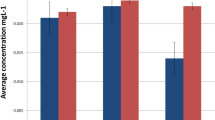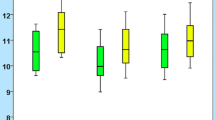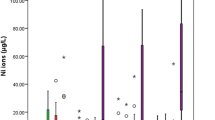Abstract
Nickel and chromium existing in stainless-steel crowns (SSCs, used in pediatric dentistry) might be cytotoxic and allergenic. However, no in vivo studies have examined their salivary levels in children using SSCs, or in young children without SSCs. Also, the effect of acidity on metal ion release has not yet been evaluated in any previous in vivo studies in the whole literature. Therefore, this preliminary before-after clinical trial was conducted. Salivary nickel/chromium levels of 30 children before and after 2 months of placement of SSCs were measured using atomic absorption spectrophotometry. Salivary pH was measured with a digital pH meter. The effects of treatment, pH, number of SSCs, gender, and age on salivary ions were analyzed statistically (α = 0.05, β = 0.15). Salivary nickel concentrations increased from 4.9010 ± 4.7390 to 5.6320 ± 4.7210 μg/L (P = 0.000, paired t test). Chromium increased from 0.3273 ± 0.5214 to 0.4199 ± 0.6404 μg/L (P = 0.016). Saliva pH increased from 6.81 ± 0.52 to 7.04 ± 0.47 (P = 0.000). Ion levels were not correlated with pH (P > 0.14), except chromium in the follow-up (rho = − 0.435, P = 0.016). Nickel increase (but not chromium increase) was correlated with pH increase (rho = 0.367, P = 0.046). Age was only correlated with baseline chromium (rho = 0.373, P = 0.042). Being male was associated with baseline/follow-up nickel levels (P ≤ 0.030). SSC number was not correlated with ions or pH (P > 0.36). It was shown for the first time that SSCs might increase salivary nickel and chromium concentrations and reduce saliva acidity. Nickel increase might be in line with pH elevation. The raised pH might be associated with reduced chromium release. Boys might have higher nickel levels than might girls, with or without SSCs.


Similar content being viewed by others
References
Casamassimo PS, Fields HW, McTigue DJ, Nowak A (2013) Pediatric dentistry: infancy through adolescence. Elsevier Health Sciences, Philadelphia
Seale NS, Randall R (2015) The use of stainless steel crowns: a systematic literature review. Pediatr Dent 37:145–160
Jurela A, Verzak Ž, Brailo V, Škrinjar I, Sudarević K, Janković B (2018) Salivary electrolytes in patients with metallic and ceramic orthodontic brackets. Acta Stomatol Croat 52:32–36
House K, Sernetz F, Dymock D, Sandy JR, Ireland AJ (2008) Corrosion of orthodontic appliances—should we care? Am J Orthod Dentofac Orthop 133:584–592
Amini F, Borzabadi Farahani A, Jafari A, Rabbani M (2008) In vivo study of metal content of oral mucosa cells in patients with and without fixed orthodontic appliances. Orthod Craniofac Res 11:51–56
Matos de Souza R, Macedo de Menezes L (2008) Nickel, chromium and iron levels in the saliva of patients with simulated fixed orthodontic appliances. Angle Orthod 78:345–350
Amini F, Jafari A, Amini P, Sepasi S (2012) Metal ion release from fixed orthodontic appliances—an in vivo study. Eur J Orthod 34:126–130
Eliades T, Athanasiou AE (2002) In vivo aging of orthodontic alloys: implications for corrosion potential, nickel release, and biocompatibility. Angle Orthod 72:222–237
Hwang CJ, Shin JS, Cha JY (2001) Metal release from simulated fixed orthodontic appliances. Am J Orthod Dentofac Orthop 120:383–391
Genelhu MC, Marigo M, Alves-Oliveira LF, Malaquias LC, Gomez RS (2005) Characterization of nickel-induced allergic contact stomatitis associated with fixed orthodontic appliances. Am J Orthod Dentofac Orthop 128:378–381
Faccioni F, Franceschetti P, Cerpelloni M, Fracasso ME (2003) In vivo study on metal release from fixed orthodontic appliances and DNA damage in oral mucosa cells. Am J Orthod Dentofac Orthop 124:687–693 discussion 693-684
Mikulewicz M, Chojnacka K (2010) Trace metal release from orthodontic appliances by in vivo studies: a systematic literature review. Biol Trace Elem Res 137:127–138
Mikulewicz M, Chojnacka K (2011) Release of metal ions from orthodontic appliances by in vitro studies: a systematic literature review. Biol Trace Elem Res 139:241–256
Kocadereli L, Atac PA, Kale PS, Ozer D (2000) Salivary nickel and chromium in patients with fixed orthodontic appliances. Angle Orthod 70:431–434
Agaoglu G, Arun T, Izgi B, Yarat A (2001) Nickel and chromium levels in the saliva and serum of patients with fixed orthodontic appliances. Angle Orthod 71:375–379
Natarajan M, Padmanabhan S, Chitharanjan A, Narasimhan M (2011) Evaluation of the genotoxic effects of fixed appliances on oral mucosal cells and the relationship to nickel and chromium concentrations: an in-vivo study. Am J Orthod Dentofac Orthop 140:383–388
Hafez HS, Selim EM, Kamel Eid FH, Tawfik WA, Al-Ashkar EA, Mostafa YA (2011) Cytotoxicity, genotoxicity, and metal release in patients with fixed orthodontic appliances: a longitudinal in-vivo study. Am J Orthod Dentofac Orthop 140:298–308
Amini F, Rakhshan V, Mesgarzadeh N (2012) Effects of long-term fixed orthodontic treatment on salivary nickel and chromium levels: a 1-year prospective cohort study. Biol Trace Elem Res 150:15–20
Amini F, Rakhshan V, Sadeghi P (2012) Effect of fixed orthodontic therapy on urinary nickel levels: a long-term retrospective cohort study. Biol Trace Elem Res 150:31–36
Amini F, Mollaei M, Harandi S, Rakhshan V (2015) Effects of fixed orthodontic treatment on hair nickel and chromium levels: a 6-month prospective preliminary study. Biol Trace Elem Res 164:12–17
Khaneh Masjedi M, Niknam O, Haghighat Jahromi N, Javidi P, Rakhshan V (2016) Effects of fixed orthodontic treatment using conventional, copper-included, and epoxy-coated nickel-titanium archwires on salivary nickel levels: a double-blind randomized clinical trial. Biol Trace Elem Res 174:27–31
Khaneh Masjedi M, Haghighat Jahromi N, Niknam O, Hormozi E, Rakhshan V (2017) Effects of fixed orthodontic treatment using conventional (two-piece) versus metal injection moulding brackets on hair nickel and chromium levels: a double-blind randomized clinical trial. Eur J Orthod 39:17–24
Eliades T, Trapalis C, Eliades G, Katsavrias E (2003) Salivary metal levels of orthodontic patients: a novel methodological and analytical approach. Eur J Orthod 25:103–106
Mikulewicz M, Chojnacka K (2011) Cytocompatibility of medical biomaterials containing nickel by osteoblasts: a systematic literature review. Biol trace element research 142(3):865–889
Fors R, Persson M (2006) Nickel in dental plaque and saliva in patients with and without orthodontic appliances. Eur J Orthod 28:292–297
Pazzini CA, Junior GO, Marques LS, Pereira CV, Pereira LJ (2009) Prevalence of nickel allergy and longitudinal evaluation of periodontal abnormalities in orthodontic allergic patients. Angle Orthod 79:922–927
Freitas MP, Oshima HM, Menezes LM (2011) Release of toxic ions from silver solder used in orthodontics: an in-situ evaluation. Am J Orthod Dentofac Orthop 140:177–181
Macedo de Menezes L, Cardoso Abdo Quintão C (2010) The release of ions from metallic orthodontic appliances. Semin Orthod 16:282–292
Amini F, Shariati M, Sobouti F, Rakhshan V (2016) Effects of fixed orthodontic treatment on nickel and chromium levels in gingival crevicular fluid as a novel systemic biomarker of trace elements: a longitudinal study. Am J Orthod Dentofac Orthop 149:666–672
Kulkarni P, Agrawal S, Bansal A, Jain A, Tiwari U, Anand A (2016) Assessment of nickel release from various dental appliances used routinely in pediatric dentistry. Indian J Dent 7:81–85
Ramazani N, Ahmadi R, Darijani M (2014) Assessment of nickel release from stainless steel crowns. J Dent (Tehran, Iran) 11:328–334
Kodaira H, Ohno K, Fukase N, Kuroda M, Adachi S, Kikuchi M, Asada Y (2013) Release and systemic accumulation of heavy metals from preformed crowns used in restoration of primary teeth. J Oral Sci 55:161–165
Menek N, Başaran S, Karaman Y, Ceylan G, Şen Tunç E (2012) Investigation of nickel ion release from stainless steel crowns by square wave voltammetry. Int J Electrochem Sci 7:6465–6471
Moreira AR, Passos IA, Sampaio FC, Soares MS, Oliveira RJ (2009) Flow rate, pH and calcium concentration of saliva of children and adolescents with type 1 diabetes mellitus. Braz J Med Biol Res 42:707–711
Hans R, Thomas S, Garla B, Dagli RJ, Hans MK (2016) Effect of various sugary beverages on salivary pH, flow rate, and oral clearance rate amongst adults. Scientifica 2016:1–6
Amini F, Harandi S, Mollaei M, Rakhshan V (2015) Effects of fixed orthodontic treatment using conventional versus metal-injection molding brackets on salivary nickel and chromium levels: a double-blind randomized clinical trial. Eur J Orthod 37:522–530
Petoumenou E, Arndt M, Keilig L, Reimann S, Hoederath H, Eliades T, Jager A, Bourauel C (2009) Nickel concentration in the saliva of patients with nickel-titanium orthodontic appliances. Am J Orthod Dentofac Orthop 135:59–65
Bhaskar V, Subba Reddy VV (2010) Biodegradation of nickel and chromium from space maintainers: an in vitro study. J Indian Soc Pedod Prev Dent 28:6–12
Menezes LM, Quintao CA, Bolognese AM (2007) Urinary excretion levels of nickel in orthodontic patients. Am J Orthod Dentofac Orthop 131:635–638
Singh DP, Sehgal V, Pradhan KL, Chandna A, Gupta R (2008) Estimation of nickel and chromium in saliva of patients with fixed orthodontic appliances. World J Orthod 9:196–202
Bishara SE, Barrett RD, Selim MI (1993) Biodegradation of orthodontic appliances. Part II. Changes in the blood level of nickel. Am J Orthod Dentofac Orthop 103:115–119
Kerosuo H, Moe G, Hensten-Pettersen A (1997) Salivary nickel and chromium in subjects with different types of fixed orthodontic appliances. Am J Orthod Dentofac Orthop 111:595–598
International Programme on Chemical Safety (1991) 108. Nickel. In: Environmental health criteria. World Health Organization, Geneva, pp 16–17
Wolowiec P, Chojnacka K, Loster BW, Mikulewicz M (2017) Do dietary habits influence trace elements release from fixed orthodontic appliances? Biol Trace Elem Res 180:214–222
Source of Funding
The study was funded by the authors and their institution.
Author information
Authors and Affiliations
Contributions
Leila Basir and Razieh Meshki searched the literature, conceived the assessment of effects of SSC treatment on nickel release, designed the study, supervised the experiments, and mentored the thesis. Azam Behbudi searched the literature, conceived the assessment of effects of SSC treatment on nickel release, designed and performed the experiments, and wrote the thesis. Vahid Rakhshan searched the literature, conceived the assessment of the role of salivary pH, SSC number, age, and gender as well as the extents of salivary chromium release, designed the study, specified and implemented the statistical analyses, interpreted and discussed the findings, and drafted/revised the article.
Corresponding author
Ethics declarations
Protocol ethics were approved by the institutional review board of the university according to the Helsinki declaration (ethical code: IR.AJUMS.REC.1395.11).
Conflict of Interest
The authors declare that they have no conflict of interest.
Rights and permissions
About this article
Cite this article
Basir, L., Meshki, R., Behbudi, A. et al. Effects of Restoring the Primary Dentition with Stainless-Steel Crowns on Children’s Salivary Nickel and Chromium Levels, and the Associations with Saliva pH: a Preliminary Before-After Clinical Trial. Biol Trace Elem Res 187, 65–73 (2019). https://doi.org/10.1007/s12011-018-1376-0
Received:
Accepted:
Published:
Issue Date:
DOI: https://doi.org/10.1007/s12011-018-1376-0




